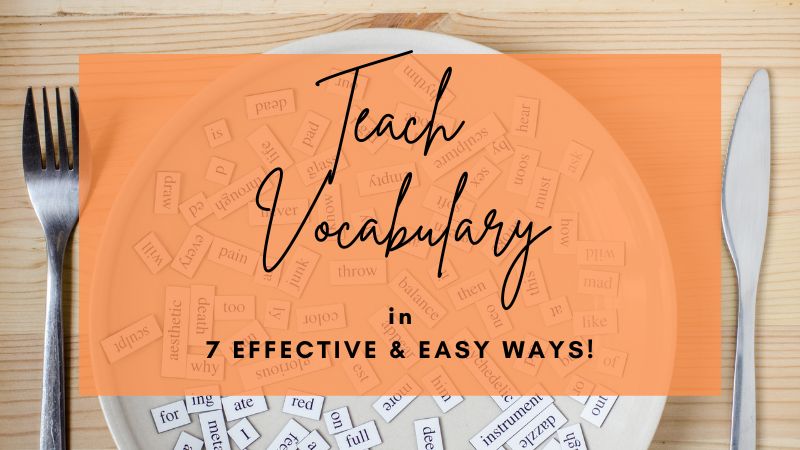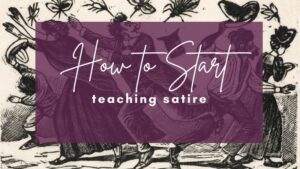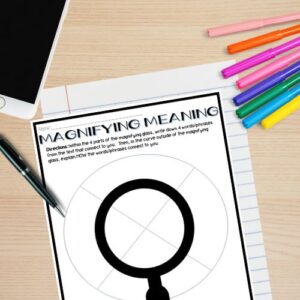When it comes to teaching vocabulary, people have many different perspectives. Some like a scripted program. Others prefer a more organic approach. I am kind of a combination of the two. At this point in my life, my most important students are my little girls. I am currently in the process of transitioning from public school teacher to homeschooling mom. Because of this transition, I am having to learn how to teach vocabulary to young children as opposed to high schoolers.
Needless to say, I am more comfortable teaching high school students.
I am learning a ton though.
And most importantly, what I am learning through homeschooling my oldest, a kindergartener, is that teaching someone how to read is a long journey of consistency.
I hope these strategies to teach vocabulary work for you!

Need help with Test Prep? Check out this FREE Pack of 3 Test Prep Activities to help students achieve success on standardized tests!
7 Ways to Teach Vocabulary
1. Read…a lot.
Reading all of the time is a huge factor in growing one’s lexicon. People completely and utterly underestimate how much a good reader simply reads.
Yes, there are students who struggle with reading because of a lack of background knowledge. Additionally, many students come to us with learning disabilities. These situations can be tough; however, reading more will, in most cases, contribute to growth, exponential growth.
Some students may develop vocabulary skills more quickly than others, but MORE exposure is helpful. I know; it seems like an easy solution, but I get it. It’s not always practical to read a lot all of the time…
Struggling readers are usually not biting at the bit to read. And that struggle is real, yet as a teacher, we should prioritize reading more if we want to teach vocabulary effectively.
Here are some simple ways to include MORE reading in your classroom AND teach vocabulary at the same time:
- Start with a bell-ringer that REQUIRES reading. Try including a one-sentence quote, a small excerpt, a fun song, or a larger passage. Then, let students silently read first. This process starts the class period off with reading!
- Put everything you say on the board. I usually project what I am saying/teaching onto the whiteboard. Plus, when students ask for help or want to clarify the instructions, the information is already there. You can simply point to it and save your breath…at least a little.
- Before reading a major text like a short story, play, novel, etc., link that text to an article connected to the time period. Providing context is key to growth.
- Don’t spend weeks reading a poem, short story, or article that can be read in a day or two. I hear of so many teachers spending weeks and weeks teaching Edgar Allan Poe’s “The Tell-Tale Heart.” While this story is a classic piece of literature, it can be read in about 30-60 minutes. If you want to do several activities like a quiz, a character analysis, and a visualization worksheet, try to work on completing those assignments in 2-3 days. Then, move on to another text, like “The Raven” or “Annabel Lee” to expose students to similar writing but different stories!
- If you watch something like a documentary or short video to introduce a passage, include subtitles. I don’t believe I am hard of hearing, but I miss so much when my mind wanders. Activating the subtitles feature allows students to read and listen, a simple technique that I use every day.
- Include a read-aloud when you can. Have a story or informational passage on standby at the end of each day. It does NOT have to relate to anything. And I don’t know about you, but those last 5 minutes of the day are sometimes just dead space while students are packing up or getting ready to leave for the day. Have them quietly get their stuff together and read 🙂
- Offer extension activities for extra credit that require reading. We all know that the students who need the extra credit ALSO should be reading more. Why not include a reading passage and activity they have not read before?
2. Reread.
One thing about little kids is that they ALWAYS want to read stories they are already familiar with. My girls and I are constantly going to the library to pick up about 20-30 new books every 2 weeks or so. During the two weeks with the same books, we read about 10-15 books a day. At that pace, we will reread those books several times.
On some days, we might read the book in the morning and at night. I personally don’t get a lot from reading the same children’s books over and over, but my girls most certainly do.
They love to hear the stories over and over and over and over…well, you get the picture.
Through the rereading process, my girls hear the same words and phrases over a 2 week period. Because of this process, their vocabularies are growing at an incredible pace.
I would definitely encourage you to model rereading for your students. Too often, students think they are bad readers because they need to reread. In fact, good readers reread all of the time!
3 Ways to Model Rereading:
- Reread directions. Yes, students don’t usually read directions the first time, but this skill is vital for success beyond the classroom.
- Reread poetry several times. We need to hear poetry and/or songs many times before we usually understand the language, nuances, and overall meaning.
- Reread important phrases, sentences, or chunks of a passage. This process helps me by getting my train of thought back on track, reinforcing what I previously read, and preparing me for the next part of the passage.
Through rereading, you can teach vocabulary as this strategy provides additional exposure. And really, none of us learns a new word in one round. We usually need to hear words again and again to truly understand a word and ultimately use it.
3. Read a variety of texts.
My kindergartener will try to read just about everything.
When we go to the zoo, she reads the brochures.
When we go for a walk, she reads the signs.
When we watch television, she reads the subtitles.
When we work on math, she reads the word problems.
When we study the bible, she reads the verses.
Now, how can we apply these ideas as we teach vocabulary in a middle or high school classroom?
- Teach through thematic units: The texts can relate in some way, so students can reinforce their knowledge. For example, if you are teaching Romeo and Juliet, you might read a love poem, an informational reading comprehension passage, a journal entry, a recipe, a news article, etc.
- Teach reading passages that link to other classes: If your 10th graders are taking biology, you could read an article about a famous scientist, a poem about a frog, or a scientific journal.
- Teach what you love but also what you struggle with: So often, our students think we LOVE reading Shakespeare or specific stories that our districts mandate. Unfortunately, this is most certainly not true. I don’t enjoy reading about two teenagers who “fall in love,” get married after like a week, and commit suicide soon after. It is not my thing. And students need to see that we are willing to read texts that we don’t want to. It is just a part of life.
- Teach vocabulary NOT found in a traditional textbook: I don’t know about you, but there are so many things I have to read throughout my day. If I go to a restaurant, I might read the menu with all of the descriptions. If I go to my accountant, I might have to read a bunch of financial jargon. If I go to the grocery store, I need to know how to read the labels. If I apply for a job, I have to read all of the requirements, restrictions, questions, etc., in order to be successful in my application. Heck, have you ever tried to read directions for putting together a piece of furniture from IKEA?
4. Read higher-level passages with your students.
I know the next statement may be controversial; however, I am okay with a bit of controversy every now and then.
I think a big mistake many teachers make is reading texts that are too low-level “with” their students.
There, I said it.
Now, let me clarify.
Students do need opportunities to read texts at their level. And I am completely okay with this. My daughter reads to me all of the time, and most of what she reads is at or only slightly above her personal reading level.
What I do read with her or to her are texts above her level. During the reading, I might stop and talk with her about certain words or ideas, so she can learn the vocabulary a bit at a time.
Then, when she rereads the passages, she becomes more and more familiar with the higher-level words.
Most of my struggling readers need passages that challenge them and stretch them. And it is super effective to read those texts with them, because you can, in effect, teach vocabulary without all of the muss and fuss of adding in separate vocabulary instruction.
Use higher-level passages to guide you and your students in growing their vocabulary!
Want to teach satire? Check out this post for help—> Teaching Satire
5. Pre-Read for Vocabulary.
One of the toughest texts I have ever had to teach is “A Modest Proposal” by Jonathan Swift. It is difficult, even for the most advanced students. So you must teach vocabulary at least a little bit for this text.
Here is the first paragraph from this classic piece of satire:
It is a melancholy object to those, who walk through this great town, or travel in the country, when they see the streets, the roads and cabbin-doors crowded with beggars of the female sex, followed by three, four, or six children, all in rags, and importuning every passenger for an alms. These mothers instead of being able to work for their honest livelihood, are forced to employ all their time in stroling to beg sustenance for their helpless infants who, as they grow up, either turn thieves for want of work, or leave their dear native country, to fight for the Pretender in Spain, or sell themselves to the Barbadoes.
Some words students might struggle with include the following as you work to teach vocabulary: melancholy, importuning, alms, employ, and sustenance.
Now, a teacher might argue that this text is too high-level for his/her high school students, and I totally understand; however, we are doing our students a disservice if we say it is too difficult, so we won’t even attempt it.
Students get satire. They are exposed to it on a daily basis through tv shows, videos, and music. They might not understand every word, but when we as teachers know the words they will struggle with, we can mediate that difficulty a bit by adding in a synonym as we read. See below!
It is a melancholy (extremely sad), object to those, who walk through this great town, or travel in the country, when they see the streets, the roads and cabbin-doors crowded with beggars of the female sex, followed by three, four, or six children, all in rags, and importuning (asking) every passenger for an alms (money). These mothers instead of being able to work for their honest livelihood, are forced to employ (work) all their time in stroling to beg sustenance (food) for their helpless infants who, as they grow up, either turn thieves for want of work, or leave their dear native country, to fight for the Pretender in Spain, or sell themselves to the Barbadoes.
If you teach vocabulary in this way, it becomes almost second nature for your students to hear the word and get the definition right away. They need this!
You don’t have to make a big deal about it in a large word study or activity; simply embedding the definitions can be a great start to learning new words.
6. Read and Write the Words.
As you teach vocabulary, you will learn one thing: Vocabulary cannot really be taught in isolation. Too often, test prep books offer a massive list of, let’s say, 1,000 words to know before you take the big standardized test. Well, simply practicing the words and their definitions over and over again does not lead to lasting learning.
It might help at the moment, but most vocabulary I learned in preparation for college tests I just don’t remember. I remember words I read and subsequently used.
After reading a passage, why not have your students practice using a set of vocabulary words from the passage? It doesn’t have to be a long, drawn-out process to teach vocabulary.
- Let students pick out words they struggle with or provide a list to choose from.
- Help students discover the meaning of the word; it is okay to tell them or to let them look up the word in the dictionary.
- Encourage students to come up with creative sentences using the words. The more creative and meaningful, the better!
See this readymade activity to help you teach vocabulary!
7. Read and Visualize the Words.
One major thing I do as a reader is visualize. While most of our kids, including my daughters, have highly active imaginations, some of our students don’t know to activate visualization as they read. This process is vital if you want to teach vocabulary!
Because reading requires visualization, when students who don’t visualize come across unknown words, they don’t connect to a possible meaning of the word. And let’s face it, we need to understand the context to determine the meaning of most words.
So, take a moment and have students draw images associated with certain vocabulary words. They don’t need to be the next Picasso to draw; they just need to create something connected to that word.
Don’t “draw” out the activity beyond 5 minutes. Just let them have fun as they learn and you teach vocabulary!
Need more fun lessons and activities that help you teach vocabulary? Check out my store Kristin Menke-Integrated ELA Test Prep!





